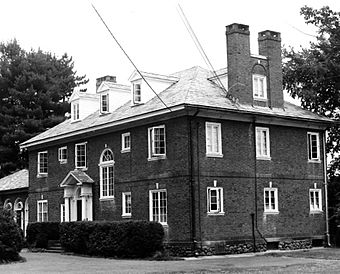Charles H. Norton House facts for kids
|
Charles H. Norton House
|
|

Charles H. Norton House in 1975
|
|
| Location | 132 Redstone Hill, Plainville, Connecticut |
|---|---|
| Built | 1922 |
| Architectural style | Colonial Revival |
| NRHP reference No. | 76002139 |
Quick facts for kids Significant dates |
|
| Added to NRHP | May 11, 1976 |
| Designated NHL | May 11, 1976 |
The Charles H. Norton House, also known as Sharpenhoe, is a special old house in Plainville, Connecticut. It was built in 1922. This brick house was the home of a famous inventor named Charles Hotchkiss Norton. He lived here from 1922 until he passed away. The house became a National Historic Landmark in 1976. This was because of Norton's important work. He invented amazing machines that helped the car industry grow.
Contents
About the Norton House: Sharpenhoe
The house, which Charles Norton called Sharpenhoe, is a two-story building made of brick. It has a sloped roof and three chimneys. The front of the house has many windows of different sizes. One special window on the right side is double-sized with a rounded top. The main front door is on the left side. It has a rounded window above it. A small porch with columns covers the door. The roof also has three small windows sticking out. This house is important because of who lived there, not so much for its design.
Who Was Charles Norton?
Charles Norton was born in Plainville in 1851. His father was a cabinetmaker. When Charles was 15, he started working at the Seth Thomas Clock Company. He worked there for 20 years. He became a manager and learned how to make parts that could be easily swapped out. This was a very important skill for factories.
Norton's Inventions and Impact
After working with clocks, Charles Norton moved to Providence, Rhode Island. He worked at a company called Brown & Sharpe. There, he became an expert in making very precise grinding machines. These machines could shape metal with great accuracy.
In his later years, Norton used his skills to help many types of factories. He was especially important for the new car industry. His grinding machines helped make car parts better and faster. This made cars more affordable for everyone. Sharpenhoe was the house where he lived after he retired. He spent the last 20 years of his life there.
Images for kids




